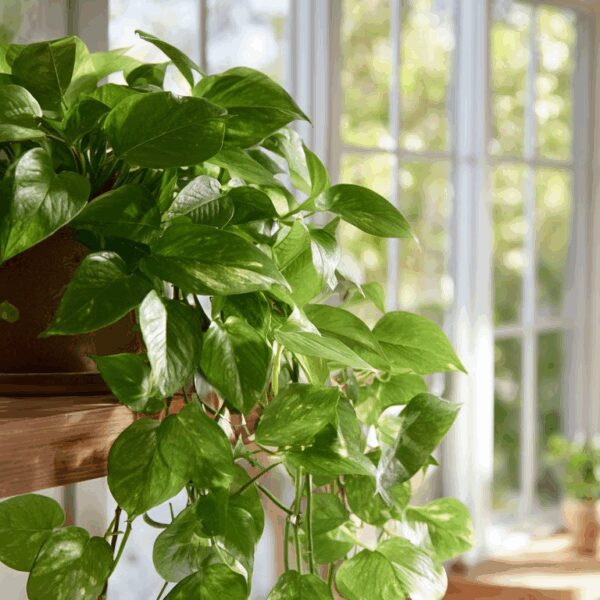If you’re looking to breathe a little easier at home, you might want to consider adding some air-purifying plants to your collection. Peace Lilies, with their stunning white blooms and lush greenery, aren’t just pretty—they can actually help clear the air of toxins while bringing a touch of nature indoors. And trust me, caring for them is like nurturing a friend; they’ll thrive with a bit of attention and the right conditions!
🌱 Green Thumb Essentials in 4 Points:
- Peace Lilies can help purify the air—think of them as your green roommates! 🌿 They soak up toxins like formaldehyde and benzene. Just remember, they’re not miracle workers—so don’t rely solely on them for a fresh space.
- As fall rolls in, keep your Peace Lily cozy! 🏡 They love bright, indirect light but can handle lower light too. Rotate your plant for even growth and watch out for yellowing leaves—it might be too much sun or water! ☀️💧
- Watering can be tricky! Aim for consistently moist soil, but not soggy. Check that top inch—if it’s dry, it’s time for a drink! 🥤 And during chilly months, ease up on the watering. No one wants root rot ruining the party!
- Keep pests at bay! 👀 If you spot webbing or sticky leaves, rinse those little critters away with water. For stubborn pests, neem oil or insecticidal soap can save the day—easy peasy from your local garden store! 🛒
Do Peace Lilies Really Clean the Air?
So, you’ve probably heard that Peace Lilies (Spathiphyllum) can help purify the air in your home. It’s a popular belief, and there’s some science to back it up, thanks to studies by NASA and other researchers. But do they really make a significant difference? The short answer is yes, to an extent. These beauties can absorb certain toxins like formaldehyde, benzene, and mold spores. If you’ve got them in your living room or bedroom, they can help improve air quality—but don’t expect them to do all the heavy lifting. Think of them as helpful little companions rather than miracle workers.
Seasonal Care: Keeping Your Peace Lily Happy This Fall
As we enter October, it’s prime time for indoor gardening. Days are getting shorter, and temperatures are dropping, which can stress out your houseplants. Peace Lilies thrive in bright, indirect light but can adapt to lower light conditions—perfect for those cozy fall afternoons when you want to curl up with a good book. Make sure to rotate your plant occasionally for even growth; those leaves will stretch towards the light! And if you notice yellowing leaves, it could be a sign of too much direct sunlight or overwatering.
Watering Wisdom: How Much is Too Much?
Watering is where many plant parents stumble. Peace Lilies like their soil to be consistently moist but not soggy. Check the top inch of soil; if it feels dry, it’s time for a drink. During cooler months, they won’t need as much water—so adjust your routine accordingly! Overwatering can lead to root rot, which is a fast track to losing your beloved plant.
Signs Your Peace Lily Needs Water
If your leaves are drooping or turning yellow, give them a check! A little wilting is normal; they’ll perk right back up after watering. Just make sure not to wait too long between drinks.
Why Your Pothos Is Turning Yellow (And How to Fix It Fast)
Pest Patrol: Keeping Your Plant Healthy
This time of year also brings indoor pests like spider mites and aphids. Keep an eye out for webbing or sticky residue on your leaves—those are telltale signs that something’s off. If you spot pests, don’t panic! A gentle rinse in the sink can often wash them away. For more stubborn infestations, try neem oil or insecticidal soap available at Home Depot or Lowe’s.
Fertilizing: What Your Peace Lily Craves
Now let’s talk food! During spring and summer (their active growth period), feed your Peace Lily every 6-8 weeks with a balanced fertilizer like Miracle-Gro. But as we drift into fall and winter, cut back on feeding since growth slows down around this time. Too much fertilizer can lead to salt buildup in the soil—nobody wants that!
The Right Fertilizer
A good rule of thumb is to look for fertilizers that list nitrogen (N), phosphorus (P), and potassium (K) on the label—aim for something balanced like 10-10-10.
Repotting: When Is It Time?
If your Peace Lily starts looking root-bound—when roots are poking out of the drainage holes—it might be time for a new pot. Generally, repot every couple of years using fresh potting mix that’s well-draining but still retains moisture well. A mix designed for tropical plants works great!
Love Your Peace Lily
Your Peace Lily isn’t just another pretty face; it’s a resilient plant that brings life into any space while potentially helping improve air quality. With the right care—especially during these shorter days—you can enjoy its stunning white blooms and vibrant green leaves throughout fall and beyond. Remember to listen to your plant’s cues and adjust care as needed; after all, every green friend has its unique needs!







